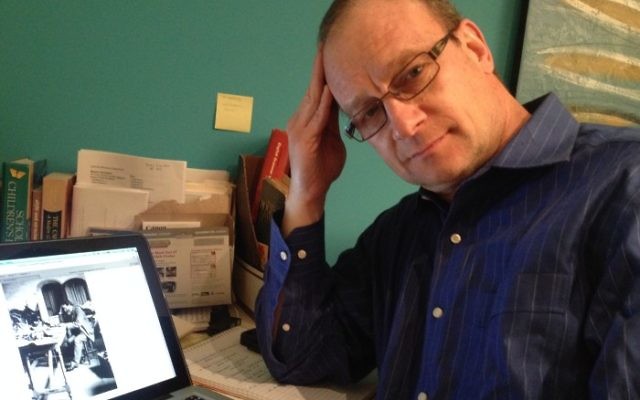A Life Well Lived, Well Loved
Dave remembers his mother-in-law, who believed that "If you don't have any art in your life, it's empty."
Dave Schechter is a veteran journalist whose career includes writing and producing reports from Israel and elsewhere in the Middle East.
Standing in front of her grave, my wife’s brother reminded us that the woman we knew as a mother, grandmother, mother-in-law, wife, sister, and friend had been taken from us years ago by the disease that extinguished her vibrant, energetic, and loving presence.
Death freed her from the mental and physical prison of Alzheimer’s. My brother-in-law asked that we close our eyes: “Imagine how she looked, what she wore, perhaps how she smelled. The lightness of her touch, the sweetness of her voice. Imagine the good times. A life well lived. A life well loved.”
This was the family’s third trip in 16 months to the Hebrew Cemetery in Rock Island, Ill. On a sweltering day in August 2021, our sons finished the job of shoveling dirt into the grave of their grandfather, my father-in-law, Marty Galex. We returned in November 2022 for the unveiling of his gravestone, half of which was left blank.
In late December, we huddled beneath a tent for funeral of Roberta Faye Levinson Galex.
Mother-in-law jokes are a dime a dozen, many suggesting dislike. I loved mine.
The first time I came to pick up Audrey, I introduced myself and was told: “I’m not Mrs. Galex. Mrs. Galex is my mother-in-law. You call me Bobbie.”
The first time I met Audrey’s grandmother, I introduced myself and was told: “I’m not Mrs. Galex. Mrs. Galex is my daughter-in-law. You call me ‘Sugie.’” [Her given name was Rose.]
I never again called either Mrs. Galex.
Bobbie was a senior at Miami Beach Senior High School when she met Marty, who was attending an Alpha Epsilon Pi convention with fraternity brothers from the University of Iowa. She attended Iowa for a year before they married in June 1957.
The Florida girl moved to Moline, Ill., and then neighboring Rock Island, where Marty worked in the mattress manufacturing business started by his parents and an uncle. [An aside: It turned out that Marty’s first solo delivery run was to a furniture store in Des Moines, Iowa, managed by my mother’s uncle.]
Audrey was born first, then Harriet. Stuart died soon after birth. Several years after Debbie was born, Michael was added to the family.
Many years ago, Bobbie told The (Moline) Dispatch that marrying at age 19 “didn’t leave much time for a career.” Whatever educational and professional (operatic singing) aspirations she gave up, her energies were devoted to the children.
“She recognized each of us as individuals and facilitated our passions. Each of us was treated as if we were gold,” Harriet said as I prepared Bobbie’s obituary.
Bobbie volunteered with numerous community organizations. She maintained a life-long love of the arts, performing in community musical theater and, beginning in childhood, painting.
When Marty retired in 1990, he and Bobbie moved to Boca Raton, Fla. They were happiest when their home was filled with friends and family, particularly the grandchildren, who looked on the country club setting as a resort.
A portion of the garage served as Bobbie’s art studio, where she shared her love of painting with the grandchildren.
After surviving a life-threatening illness in 1996, Bobbie became active in Women in the Visual Arts (WITVA). She founded a program called HOSPITALART, which provided hundreds of paintings for display at hospitals, clinics, and other facilities.
“I felt like I was in solitary. I had nothing to see,” Bobbie told the Palm Beach Post about her illness. “It is so frightening to have just a white wall. There was nothing to take your mind off your troubles.”
“People are suffering, it only adds to their pain to be surrounded by empty walls,” she told the Sun-Sentinel. “If you don’t have any art in your life, it’s empty.”
Bobbie’s funeral was held after a week of sub-zero temperatures warmed to the merely sub-freezing. Trodding through several inches of snow, the family placed stones on Marty’s grave, on Stuart’s, and on those of Marty’s parents, Rose and Wilbur.
One explanation for the Jewish custom of placing stones on a grave is a belief that doing so keeps the soul in this world. Another is that stones symbolize the permanence of memory and legacy.
We will return later this year for an unveiling as Bobbie’s name is added to the gravestone. These bittersweet gatherings have enhanced relationships between branches of the family, particularly among the grandchildren. That would have pleased Bobbie immensely.
- From Where I Sit
- Opinion
- Dave Schechter
- Death
- funeral
- grave
- Alzheimer's
- Hebrew Cemetery
- Rock Island
- Marty Galex
- Roberta Faye Levinson Galex
- Miami Beach Senior High School
- Alpha Epsilon Pi
- University of Iowa
- Des Moines
- The Moline Dispatch
- Boca Raton
- Women in the Visual Arts (WITVA)
- HOSPITALART
- Palm Beach Post
- Sun-Sentinel




comments